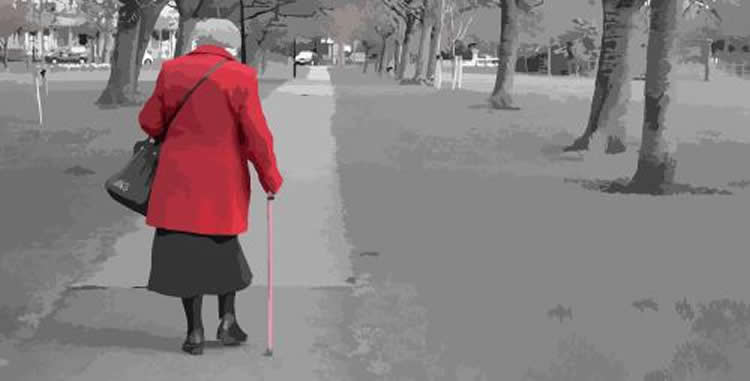One day soon, doctors may determine how physically active you are simply by imaging your brain. Physically fit people tend to have larger brain volumes and more intact white matter than their less-fit peers. Now a new study reveals that older adults who regularly engage in moderate to vigorous physical activity have more variable brain activity at rest than those who don’t. This variability is associated with better cognitive performance, researchers say.
The new findings are reported in the journal PLOS ONE.
“We looked at 100 adults between the ages of 60 and 80, and we used accelerometers to objectively measure their physical activity over a week,” said University of Illinois postdoctoral researcher Agnieszka Burzynska, who led the study with Beckman Institute for Advanced Science and Technology director Art Kramer.
The researchers also used functional MRI to observe how blood oxygen levels changed in the brain over time, reflecting each participant’s brain activity at rest. And they evaluated the microscopic integrity of each person’s white-matter fibers, which carry nerve impulses and interconnect the brain.
“We found that spontaneous brain activity showed more moment-to-moment fluctuations in the more-active adults,” said Burzynska, who now is a professor at Colorado State University. “In a previous study, we showed that in some of the same regions of the brain, those people who have higher brain variability also performed better on complex cognitive tasks, especially on intelligence tasks and memory.”
The researchers also found that, on average, older adults who were more active had better white-matter structure than their less-active peers.
“Our study, when viewed in the context of previous studies that have examined behavioral variability in cognitive tasks, suggests that more-fit older adults are more flexible, both cognitively and in terms of brain function, than their less-fit peers,” Kramer said.

The new research highlights yet another way to assess brain health in aging, Burzynska said.
“We want to know how the brain relates to the body, and how physical health influences mental and brain health in aging,” she said. “Here, instead of a structural measure, we are taking a functional measure of brain health. And we are finding that tracking changes in blood-oxygenation levels over time is useful for predicting cognitive functioning and physical health in aging.”
Source: Diana Yates – University of Illinois at Urbana-Champaign
Image Source: The image is credited to Julie McMahon
Original Research: Full open access research for “Physical Activity Is Linked to Greater Moment-To-Moment Variability in Spontaneous Brain Activity in Older Adults” by Agnieszka Z. Burzynska, Chelsea N. Wong, Michelle W. Voss, Gillian E. Cooke, Neha P. Gothe, Jason Fanning, Edward McAuley, and Arthur F. Kramer in PLOS ONE. Published online August 5 2015 doi:10.1371/journal.pone.0134819
Abstract
Physical Activity Is Linked to Greater Moment-To-Moment Variability in Spontaneous Brain Activity in Older Adults
Higher cardiorespiratory fitness (CRF) and physical activity (PA) in old age are associated with greater brain structural and functional integrity, and higher cognitive functioning. However, it is not known how different aspects of lifestyle such as sedentariness, light PA (LI-PA), or moderate-to-vigorous physical activity (MV-PA) relate to neural activity in aging. In addition, it is not known whether the effects of PA on brain function differ or overlap with those of CRF. Here, we objectively measured CRF as oxygen consumption during a maximal exercise test and measured PA with an accelerometer worn for 7 days in 100 healthy but low active older adults (aged 60–80 years). We modeled the relationships between CRF, PA, and brain functional integrity using multivariate partial least squares analysis. As an index of functional brain integrity we used spontaneous moment-to-moment variability in the blood oxygenation level-dependent signal (SDBOLD), known to be associated with better cognitive functioning in aging. We found that older adults who engaged more in LI-PA and MV-PA had greater SDBOLD in brain regions that play a role in integrating segregated functional domains in the brain and benefit from greater CRF or PA, such as precuneus, hippocampus, medial and lateral prefrontal, and temporal cortices. Our results suggest that engaging in higher intensity PA may have protective effects on neural processing in aging. Finally, we demonstrated that older adults with greater overall WM microstructure were those showing more LI-PA and MV-PA and greater SDBOLD. We conclude that SDBOLD is a promising correlate of functional brain health in aging. Future analyses will evaluate whether SDBOLD is modifiable with interventions aimed to increase PA and CRF in older adults.
“Physical Activity Is Linked to Greater Moment-To-Moment Variability in Spontaneous Brain Activity in Older Adults” by Agnieszka Z. Burzynska, Chelsea N. Wong, Michelle W. Voss, Gillian E. Cooke, Neha P. Gothe, Jason Fanning, Edward McAuley, and Arthur F. Kramer in PLOS ONE. Published online August 5 2015 doi:10.1371/journal.pone.0134819






